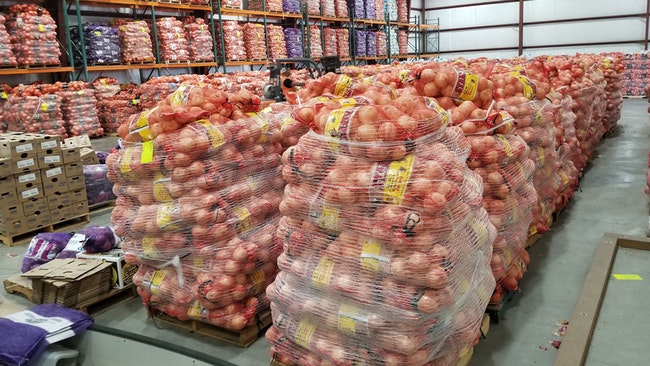
A steep shift in the weather last summer, where high temperatures scorched the county for weeks, impacted the 2021 onion harvest. (The Enterprise/File).
Heat hammered the local onion industry in 2021.
Local onion producers and packers suspected in the fall that lower yields – triggered by a wave of high temperatures last summer – could be a prevailing feature of the harvest.
Two months after the last truck departed the local onion fields, it appears their concerns were justified.
While firm yield statistics won’t be available until at least March, local onion fields aren’t producing the 43-ton per acre average hit in 2020, said Stuart Reitz, Malheur County extension agent.
The lower yields also produced smaller onions overall and created new challenges for producers and packers as demand for larger – or jumbo and colossal – onions continue to grow. Smaller onions also don’t typically fetch a high price.
Demand and prices for big onions are high, according to a December report from the Northwest Farm Credit Services.
Prices for jumbo yellow onions traded in December at between $15 and $16 per 50-pound bag in Idaho and Oregon, more than double last year’s price, according to the report.
“But there are not very many big onions to sell,” the report said.
The dismal harvest is significant for the local $80 million onion industry and many producers may have to rely on federal subsidies to survive, said Grant Kitamura, the general manager of the onion packing facility Baker & Murakami Produce Co. in Ontario.
“It is not good. It’s been a hard year,” said Kitamura.
Kitamura said he feared the high temperatures last summer would play havoc with the harvest.
“I knew there was something wrong in July but you don’t realize the actual yield of your onions until September and October,” he said.
Fewer onions means less money for growers and packing sheds, said Reitz.
The unusual summer heat wave proved to be a decisive factor in onion size.
“They just didn’t have the opportunity to grow as big as they normally would have,” said Reitz.
The long heat wave may herald a dramatic change on the horizon for all agriculture with continuing extreme variations in the climate.
“We’ve looked at weather data over the past 80 years, and yeah, the climate is changing. We see increasing temperatures and one of the other aspects to it all is we do see these variations or wide swings. I think we are setting the stage for more variability in the weather,” said Reitz.
Reitz said the high temperatures that rolled over the county last summer may become a trend.
“These kinds of extraordinary heat waves, I think that is something we have to look forward to in the future,” said Reitz.
Kitamura agreed temperatures are growing warmer over time but isn’t sure exactly why.
“There is probably some argument for climate change but there was also a drought situation. So, it could be climate change, it could be a lot of things,” he said.
Production costs for area onion producers are rising, too.
The impact of a nationwide truck driver shortage has influenced local producers, said Kitamura.
“Freight is going nuts. Fuel prices are up,” said Kitamura. “It’s a lack of drivers, not trucks.”
According to the American Trucking Associations, the truck driver shortage “will hit a historic high just over 80,000 drivers.”
The driver shortfall can’t be traced to one factor, the trucking association explained in a recent report.
The high average age of current truck drivers, inability of prospective and current drivers to pass a drug test and the impacts of the pandemic – as many drivers left the industry – all play a role in the shortage, according to the trucking associations.
Lack of drivers means fewer trucks and higher freight prices for producers.
“Freight is now probably 250 percent higher than what is was 18 months ago. It is just another contributing factor, or point of volatility, looking forward because if we are not competitive from a freight standpoint it can change the dynamic of where and what is grown,” said Shay Myers, owner of Owyhee Produce in Parma. His fields straddle the Oregon-Idaho border.
Myers estimated that now it costs a producer around $5,000 to plant an acre of onions. Last year, he said, it cost $4,400.
The poor harvest may prompt some producers to switch away from planting the number of onions in 2022 they put in the ground in 2021.
“Costs are going up. You can raise corn or grain for $500 or $600 an acre so if they (producers) can still make money doing that, why not?” said Kitamura.
Reitz said some farmers may take a break from onions this year.
“They’ve had a number of years where the prices have been so low they are not really making money doing it,” said Reitz.
Reitz said, though, he doesn’t expect a significant change in the number of acres planted.
About 22,000 acres of onions are planted on the Oregon and Idaho side of the Snake River each year.
The final intangible for the industry is the availability of water. Now, area reservoirs remain low and while a wave of recent storms helped build snow pack, more will be needed.
“The big thing is really the water situation,” said Reitz.
Reitz said “a lot of work” is going on at Oregon State University to address the impact of fluctuating weather patterns “to better manage irrigation and I think there has been some work to develop drought, low-water varieties of crops.”
News tip? Contact reporter Pat Caldwell at [email protected].
Previous coverage:
Onion harvest in Malheur County defies expectations
Blistering heat blasts Malheur County crops, could impact yield
EXCELLENCE IN JOURNALISM – Available for $5 a month. Subscribe to the digital service of the Enterprise and get the very best in local journalism. We report with care, attention to accuracy, and an unwavering devotion to fairness. Get the kind of news you’ve been looking for – day in and day out from the Enterprise.




